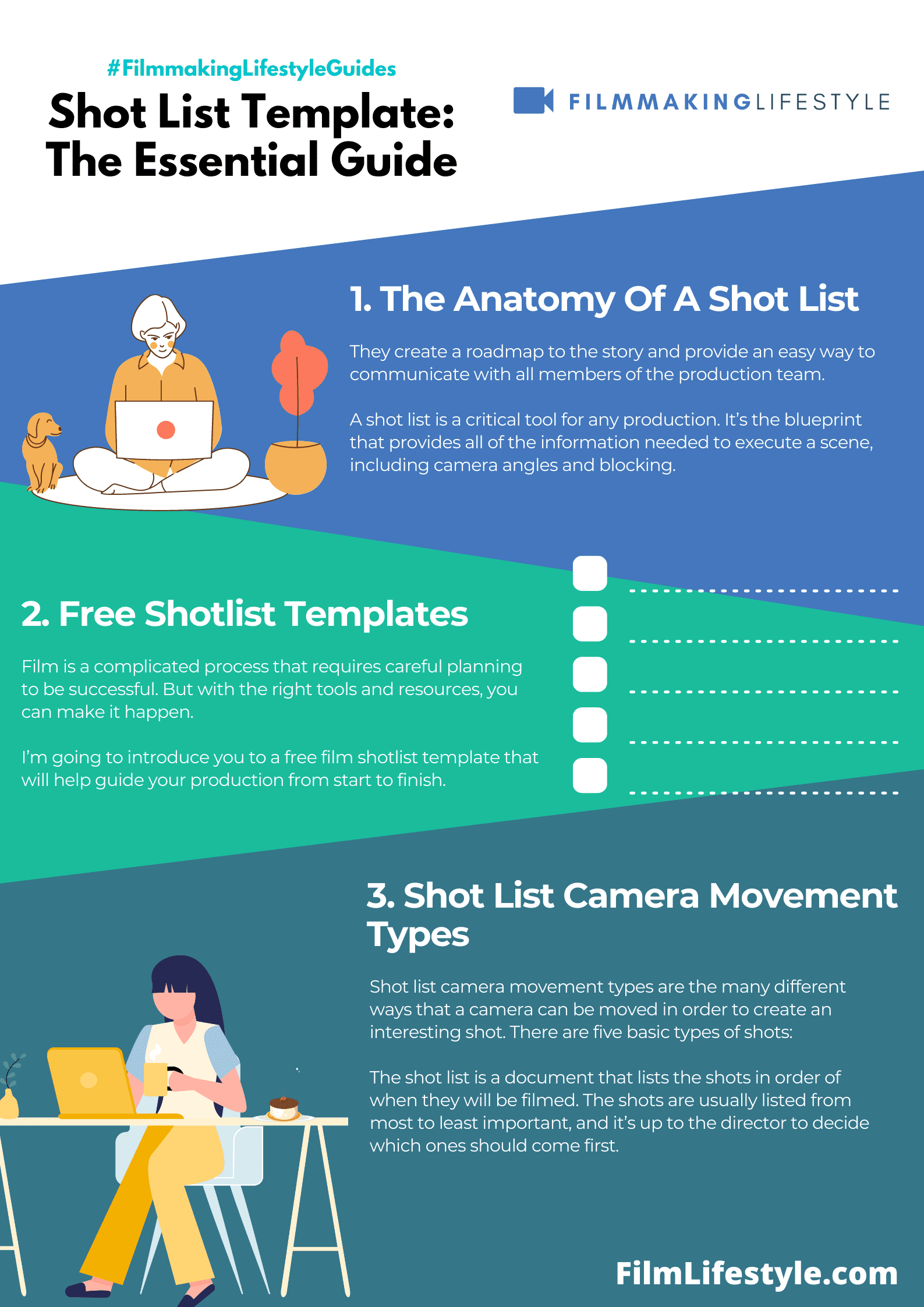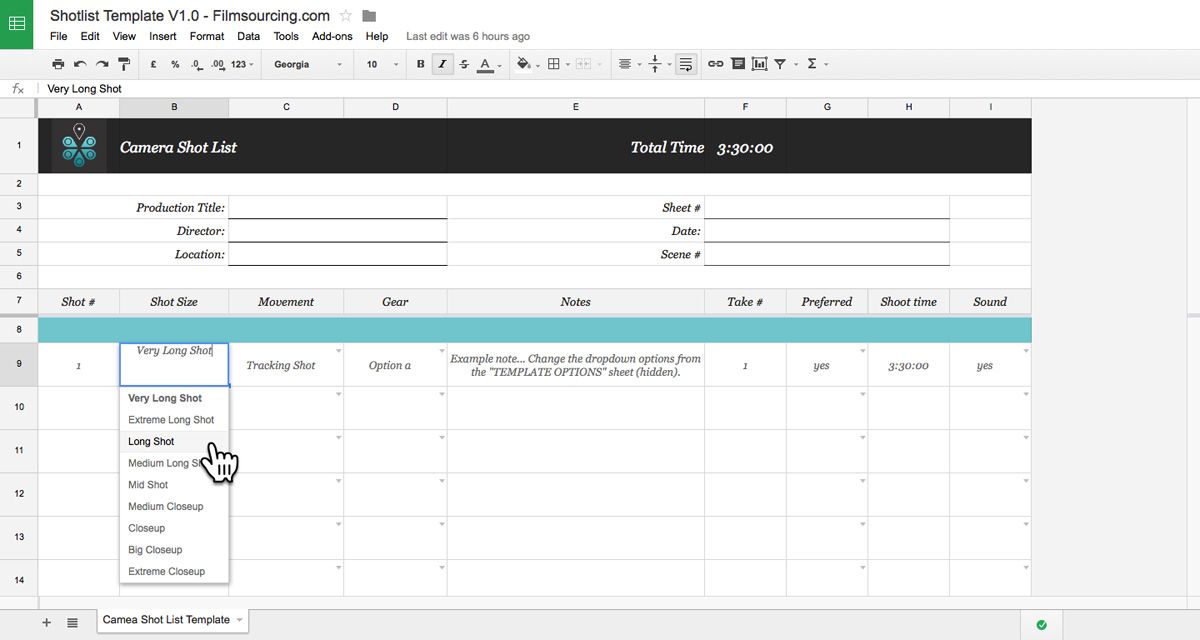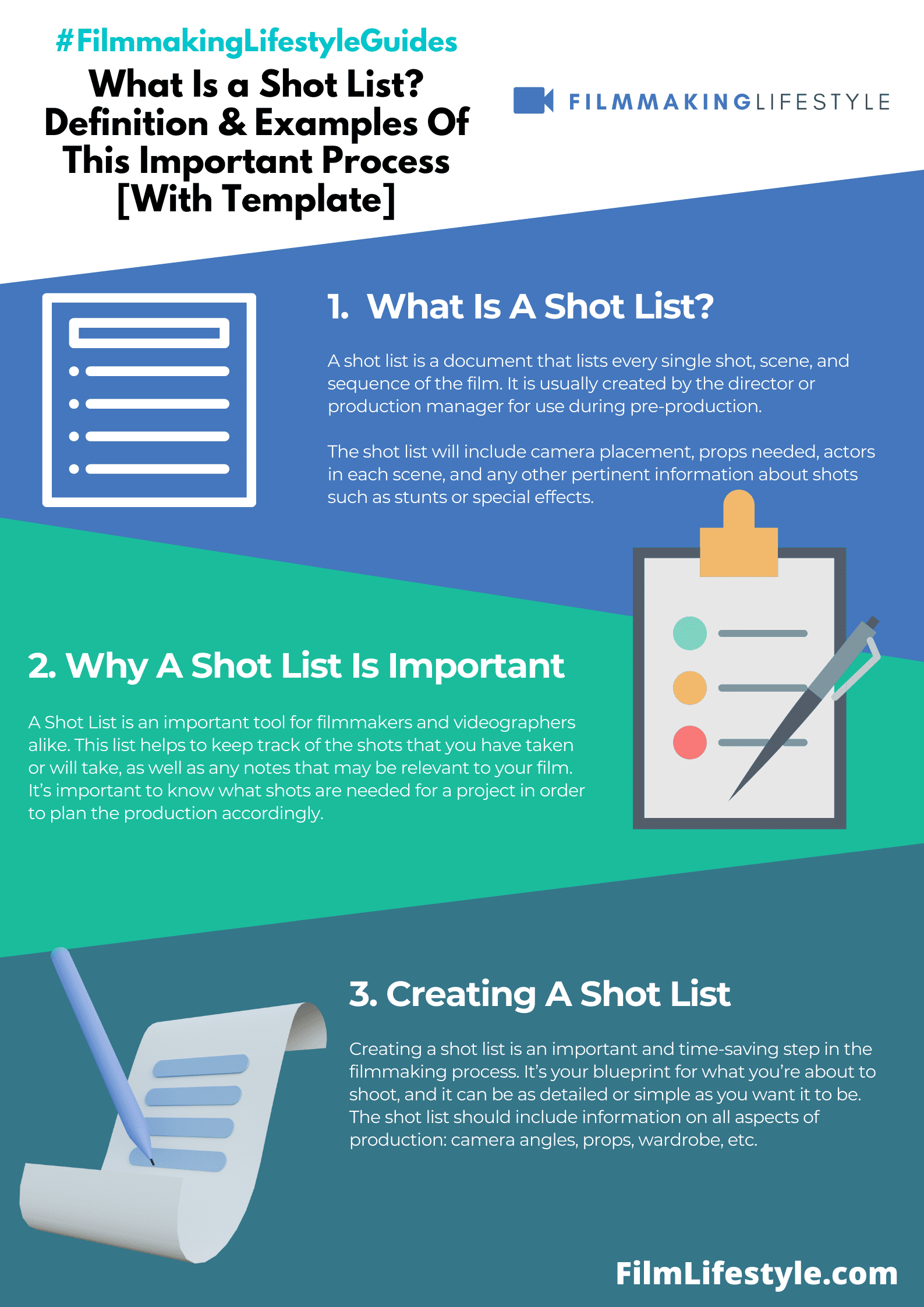Creating a shot list is like mapping the blueprint of your film’s visual storytelling.
With the right shot listing software, we can transform our vision into a detailed plan that guides every frame.
Imagine having a tool that not only organizes your ideas but also streamlines communication with your crew.
We’re diving into the digital age of filmmaking where efficiency meets creativity.
Shot listing software isn’t just about listing shots; it’s about sculpting your film’s narrative before you even yell “Action!”
Let’s explore how to harness this powerful tool to make your production process as smooth as a Steadicam shot.
SHOT LIST TEMPLATE
What Is A Shot List Template?
A shot list template is a document that outlines the shots required for film or video production, typically in the order of their appearance.
They are used to provide filmmakers and other members of the crew with an outline of what scenes need to be filmed in advance so they can plan out how and when they will shoot them.
Shot lists are usually created by storyboarding or shooting some footage before filming begins then editing it together.
The Importance Of A Shot List
Creating a shot list is
It’s our blueprint that guides the entire crew through the production.
A well-crafted shot list brings our film’s vision closer to reality.
We crystallize our ideas onto paper, detailing every frame and movement.
This document is essential for effective resource management.
With a shot list, we allocate our time and equipment optimally.
It also ensures continuity and flow within our scenes.
The planning involved in shot listing prevents jarring transitions and maintains narrative cohesion. Also, a shot list promotes collaboration.
Every department from lighting to set design understands the expectations and can prepare accordingly.
Some key reasons for developing a shot list include –
- Clarity of vision for the entire team,
- Improved efficiency and time management,
- Assurance of narrative and visual continuity,
- Facilitation of seamless communication,
- Prevention of costly on-set uncertainties.
By harnessing the utility of shot listing software, we elevate the precision of our shot lists.
Features such as drag-and-drop interfaces and customizable templates streamline the creation process.
With digital shot lists, we easily share updates and changes in real-time.
This keeps everyone informed and adaptable to shifts in our filming schedule or creative direction.
Our experience can attest to the enhanced organization and preparation a shot list provides.
It’s a tool that solidifies our objectives and aligns our crew’s actions with our directorial vision.
Understanding Shot Listing Software
Shot listing software is much more than a digital replacement for traditional pen and paper.
It’s an interactive tool that enables filmmakers to visualize each scene and fine-tune every aspect of the shoot.
These programs come loaded with features designed to maximize creativity while keeping the production organized.
Some key functionalities include:
- Drag-and-drop interfaces for easy shot arrangement,
- Integrations with storyboard images and reference materials,
- Customizable templates for different shooting scenarios.

By using shot listing software, we’re not just creating lists; we’re building an entire ecosystem for our project.
This fosters a collaborative environment where everyone from the director to the camera crew can access and understand the plan.
Time is precious on set, and this software helps us use it wisely.
Real-time updates ensure that changes are communicated instantly, keeping everyone on the same page.
The flexibility to adapt to the unforeseen is a critical advantage.
When circumstances change, we can promptly rearrange shots without losing momentum.
Our goal is always to align our technical efforts with the creative vision of the project.
Whether it’s an Indie Film or a blockbuster, this software serves as a bridge between the two worlds.
With shot listing software, we’re embracing efficiency and innovation as part of our filmmaking process.
It’s not just about recording ideas; it’s about bringing them to life in the most effective way possible.
Simplicity in the user experience is crucial.
We need tools that don’t require hours of training so that we can focus on what truly matters – storytelling.
Each film, like Inception or The Godfather, had a detailed shot list that guided their acclaimed visual narratives.
With today’s technology, we can reach those levels of precision and beyond.
Benefits Of Using Shot Listing Software
When dealing with the complexities of a film project, the advantages of leveraging shot listing software are monumental.
It streamlines our pre-production process, setting a clear roadmap for every day of shooting.
Efficiency and organization rise to the forefront with these digital tools.
They eliminate the clutter of physical papers and binders.
We’re provided with an all-in-one platform where every camera angle, movement, and lighting setup is meticulously planned.
The software’s drag-and-drop interface simplifies the process, saving us valuable time.
The benefits are not merely administrative.
There’s an impact on our creative execution as well.
Features in the software let us align our team’s vision, offering a shared reference point for all departments.
Below are some key benefits:
- Enhanced collaboration – entire teams can access and modify the shot list in real time,
- Flexibility in planning – easy adjustments can be made when faced with last-minute changes,
- Visual support – integration with storyboard images makes translating concepts to screen effortless.
also, shot listing software often comes with an array of customizable templates tailored for different filming styles and genres.
Whether we’re working on the next indie hit or a blockbuster reminiscent of Inception, we have the ability to choose a template that best fits our project’s needs.
Through the use of powerful organizational and planning features, we ensure not a single detail is overlooked.
This commitment to precision is reflected on the screen, as seen in the iconic frames of films like The Godfather.
Continuity errors are a headache of the past with shot listing software.
By keeping a digital log of every shot, it becomes easier for us to maintain consistency across various scenes and takes.
By adopting shot listing software, we’re not just upgrading our toolkit – we’re also upgrading the final quality of our films.
Its use marks a significant leap in how we prepare for and envision the making of a movie.
Key Features To Look For In Shot Listing Software
When diving into the world of shot listing software, certain features stand out as must-haves for us.
These are the game-changers that can take a filmmaking project from good to great.
User-Friendly Interface – A clean and intuitive design is key.
We’re looking for software that simplifies the shot listing process rather than complicates it.
Features like drag-and-drop functionality and quick editing options are top of our list.
Integration with Storyboarding Tools – The ability to import images directly from storyboard software or other sources is crucial.
This integration allows us to visualize each scene alongside our shot list, ensuring a seamless transition from the page to the screen.
Let’s consider the importance of:
- Customizable Templates – Different films require different approaches. Software that offers diverse templates for genres, scenes, and camera setups can save us hours in pre-production.
- Real-time Collaboration – In filmmaking, time is money. Being able to work simultaneously with our team members on the same shot list ensures everyone stays on the same page and deadlines are met efficiently.
Then there’s data management.
Having a robust system in place for:
- Data Backup and Recovery – Our work is too important to risk losing. Software with reliable backup features means we can rest easy knowing our shot lists are safe.
- Compatibility and Export Options – We need flexibility. Being able to export our lists into various formats ensures compatibility with other tools and simplifies sharing with cast and crew.
And let’s not forget support.
Exceptional customer support and regular updates are essential for maintaining workflow and adapting to the latest filmmaking techniques.
Choosing the right software is about matching our project’s needs with the features that will support our creative vision.
That’s how we make shot listings less of a chore and more of a powerful tool in our filmmaking arsenal.

How To Create A Shot List Using Shot Listing Software
Creating a shot list with the right software begins with understanding the scene requirements.
We start by identifying the type of shots needed, such as close-ups or wide angles, and the movement involved – will the camera pan, tilt, or remain static?
Next, we add specifics to each shot.
This includes the location, time of day, and any lighting or equipment requirements.
The shot listing software we choose often provides fields for us to enter these details directly, ensuring nothing is overlooked.
We also consider the actors involved and any special actions or expressions required for each shot.
By doing so, we establish who needs to be on set and when, which is pivotal for scheduling.
A well-organized shot list is like a roadmap – it subtly directs everyone’s efforts towards the envisioned outcome.
Integrating storyboard visuals can dramatically enhance our shot list’s effectiveness.
Being able to visually tie storyboards to our shot details aids in communicating the vision behind each frame.
The right software will allow us to seamlessly attach and view these images next to our shot specifications.
We then arrange the shots in the order they will be filmed.
This is crucial for on-set efficiency, saving valuable time and resources.
Prioritizing the shots that share a location or lighting setup minimizes disruptions and maximizes our shooting time.
Real-time collaboration features can be a game-changer.
These allow our team to provide instant feedback and make necessary adjustments to the shot list.
We’re able to maintain an agile working environment where creative decisions are made swiftly and with consensus.
Finally, we review our shot list for clarity and completeness.
Ensuring that each entry is concise and well-documented means fewer misunderstandings and a smoother filming process.
With everything in place, our final task is to distribute the shot list to the cast and crew, setting the stage for successful filming days ahead.
Tips For Optimizing Your Shot List
Creating an effective shot list requires more than just a sequence of shots – it calls for strategic organizing that can translate to on-set efficiency and clarity.
We’ll walk through some tips to ensure your shot list is not only comprehensive but also optimally structured for the demands of film production.
Categorize Your Shots for ease of reference.
Grouping shots by type – close-ups, wide shots, or action sequences – allows for quicker adjustments and helps maintain continuity.
It’s a way to break down complex scenes into manageable parts.
Prioritize shots based on Lighting and Talent Availability.
Natural light can change quickly; scheduling these shots first can save time and maintain the visual consistency of your film.
Availability of actors or specific locations can also dictate the order of your shot list.
Use shot listing software features to Track the Progress of each shot throughout the day.
This real-time update can be a lifeline for directors and producers to stay on schedule.
It’ll also give instant visibility into what’s been completed and what’s pending.
Consider the Logistics of the Location when planning your shots.
Account for:
- Travel time between setups,
- Potential audio interferences,
- Traffic patterns that could affect continuity.
Label each shot with relevant metadata – lens choice, camera movement, and any special equipment needed.
This attention to detail will help your crew prepare for each shot with precision, ensuring that no time is wasted on set.
Implementing these tips within your shot listing process can streamline production workflow and enhance communication among the cast and crew.
Each step taken towards a more organized shot list is a step towards a more efficient and successful film shoot.

How To Make A Shot List Using Shot Listing Software – Wrap Up
We’ve shared our best practices for making your shot list as efficient and clear as possible.
By categorizing and prioritizing shots, using the right software tools, and paying close attention to location logistics and metadata, you’ll find that your production workflow becomes significantly more streamlined.
Remember, clear communication is the backbone of any successful film set.
With these strategies, we’re confident you’ll enhance collaboration and take your project’s production quality to the next level.
Let’s make every shot count and every moment on set productive.
Frequently Asked Questions
What Is A Shot List?
A shot list is a document that outlines all the camera shots that need to be filmed during a production shoot.
It’s a vital tool for planning your filming schedule and ensuring that every necessary shot is captured.
How Can Categorizing Shots Improve On-set Efficiency?
By categorizing shots, you help the crew quickly understand the type of setup required for each scene, which streamlines the setup process and aids in managing the filming schedule efficiently.
Why Should Shots Be Prioritized Based On Lighting And Talent Availability?
Prioritizing shots based on lighting ensures that the natural light is used effectively, and scheduling around talent availability minimizes downtime, leading to a more efficient shoot.
What Are The Benefits Of Using Shot Listing Software?
Shot listing software helps in real-time tracking of the progress, facilitates easy updates, and improves communication among the cast and crew, which enhances overall productivity on set.
How Does Considering The Logistics Of The Location Impact The Shot List?
Taking into account the logistics of the location can help in identifying potential challenges early on, allowing for changes to the shot list that minimize disruptions and delays during the shoot.
What Kind Of Metadata Should Be Labeled On Shots?
Metadata such as the type of lens, camera movement, special equipment needed, and cast involved should be labeled on shots.
This information helps the crew prepare for each shot ahead of time and ensures nothing is overlooked.



